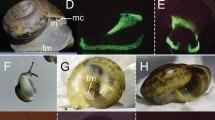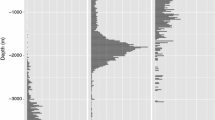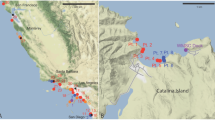Abstract
The luminescence of the solitary radiolarianThalassicolla sp. has a spectral emission maximum at 446±4 nm and the luminescence of crude homogenates can be activated by calcium ions. Electrical stimulation of single individuals frequently causes them to produce repetitive post-stimulus flashing akin to that reported in a number of other marine animals. The possible relationships between the luminescent system ofThalassicolla sp. and of certain coelenterates are discussed.
Similar content being viewed by others
Literature Cited
Anderson, O.R.: Light and electron microscope observations of feeding behavior, nutrition and reproduction in laboratory cultures ofThalassicolla nucleata. Tissue Cell10, 401–412 (1978)
Bassot, J.-M. et A. Bilbaut: Bioluminescence des élytres d'Acholoe. III. Déplacement des sites d'origine au cours des emissions. Biol. cell.28, 155–162 (1977)
Bilbaut, A. et J.-M. Bassot: Bioluminescence des élytres d'Acholoe. II. Données photometriques. Biol. cell.28, 145–154 (1977)
Blinks, J.R., F.G. Prendergast and D.G. Allen: Photoproteins as biological indicators. Pharmac. Rev.23, 1–93 (1976)
Brandt, K.: Die Koloniebildenden Radiolarien (Sphaerozoéen). Fauna Flora Golf Neapel13, 1–276 (1885)
Collier, A.F., R.J.P. Burnham and P.J. Herring: A system for the collection of comparative emission spectra suitable for shipboard use. J. mar. biol. Ass. U.K. (in press)
Esaias, W.E. and H.C. Curl: Effect of dinoflagellate bioluminescence on copepod ingestion rates: Limnol. Oceanogr.17, 901–906 (1973)
Harvey, E.N.: Oxygen and luminescence, with a description of methods for removing oxygen from cells and fluids. Biol. Bull. mar. biol. Lab., Woods Hole51, 89–97 (1926)
Herring, P.J. (Ed.): Bioluminescence in action, 570 pp. London: Academic Press 1978
Nicol, J.A.C.: Observations on luminescence in pelagic animals. J. mar. biol. Ass. U.K.37, 705–752 (1958)
Shimomura, O., F.H. Johnson and Y. Saiga: Extraction purification and properties of aequorin, a bioluminescent protein from the luminous hydromedusan,Aequorea. J. cell. comp. Physiol.59, 223–239 (1962)
Author information
Authors and Affiliations
Additional information
Communicated by J. Mauchline, Oban
Rights and permissions
About this article
Cite this article
Herring, P.J. Some features of the bioluminescence of the radiolarianThalassicolla sp.. Mar. Biol. 53, 213–216 (1979). https://doi.org/10.1007/BF00952428
Accepted:
Issue Date:
DOI: https://doi.org/10.1007/BF00952428




